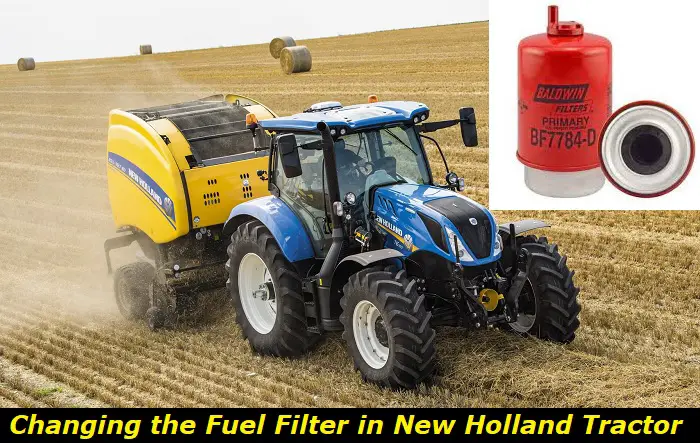How to Change Fuel Filter in New Holland Tractor? And When Is It Needed?
A fuel filter is among the most critical components in a tractor engine. It is part of the fuel system that feeds the engine to provide power for different operations. The fuel filter's work is to filter all impurities, contaminants, and micro-organisms from the fuel before it is injected into the engine combustion chamber. This is to ensure that the fuel being injected into the engine is at its highest purity.
In this article, we are going to explain when and how to change a fuel filter in the New Holland tractor. We shall also briefly explain how a fuel filter works so that you know the essence of ensuring your fuel filter is in the right working condition.

Why the Fuel Filter?
Fuel may get dirty or contaminated at any stage from the refinery, during transportation, during storage, or refueling. The fuel moving from the tank to the engine may also collect dust, impurities, and contaminants within the fuel system components. As such, the fuel must be filtered to ensure it is clean before it is injected into the combustion chamber. A poorly filtered fuel may lead to serious tractor problems such as
- Increased fuel consumption
- Mal-functioning engine
- Low power output
- Inefficient tractor operations
- Shortened engine life.
- Uneven or rough engine performance;
- Failures in the injection system and other fuel system components.
The injection motor, the injector nozzles, and the internal combustion process are very sensitive to any foreign material that may be contained in the fuel. There could be as much as 1 mm of foreign matter in every liter of diesel. The fuel filter is specifically fitted in the fuel system to:
- Arrest any solid material in the diesel
- Remove water
- Remove paraffin
- Remove organic materials and residues such as bacteria and fungi
- Remove any other contaminant that may be present.
Types of Fuel Filters
Fuel filters come in many different sizes, shapes, and categories and are used in petrol or diesel engines. However, regardless of their type, the filtering mechanism is the same. Moreover, the filtering materials in all the filters are mainly made from polyester, synthetic, or cellulose fiber filtering papers.
The categorization of fuel filters is based on various parameters such as:
1) Structure and filtration process. These include:
- Linear filters (for carburetor and injection vehicles)
- Dismountable filters (mainly for construction equipment)
- Those mounted by rotation
2) According to their filtration elements
3) What material they are made of, and,
4) According to the type of fuel they filter. Thus, we have
- Gasoline
- Diesel
- Gas/LPG filters
Despite all these categories of filters, most tractors, including the New Holland use either the ECO cartridge filter or the metal spin-on filter which are classified simply depending on how they are fixed on the tractor
- Metal spin-on filters have the filter medium inside a metal casing that is threaded into position in the fuel system. The entire case is replaced during servicing. This type of filter removes both the contaminants and any water that may be contained in the fuel. The filter may have a separate container to hold water filtered from the fuel.
- Cartridge filters only have the filtering medium contained in a metal casing. Only the medium is replaced during servicing.
Functions of a Fuel Filter in the New Holland
A fuel filter is an integral part of the diesel supply system in the NH tractor engine. Its core function is to remove any foreign material that may have contaminated the diesel before it gets into the engine.
The efficiency of the fuel filter is critical in ensuring the efficiency of the engine as well as prolonging the lifespan of the engine, and by extension, the tractor. Apart from the quality of the filter, the quality of the diesel being used will also determine how effective the filter is in its functionality. Fuel filters should have an efficiency removal rate of 99% or more.
Why change your NH tractor filter?
Contaminants in the diesel and a blocked/clogged filter decrease the engine performance of your tractor. With the efficiency of modern-day engines, there must be a corresponding fuel cleanliness to maintain power output and prolonged tractor life. Filters are expected not only to filter and clean the fuel but also to hold the contaminants until the next service.
Thus, suitable and regular servicing, maintenance, and changing fuel filters is an important part of NH operations. Fuel filters have a lifespan and must be changed upon expiry. The change can be done earlier if the tractor shows signs that the filter is clogged or damaged. They can easily become clogged due to the use of low-quality diesel or other environmental factors affecting your tractor or fuel.
Here are the steps to follow when changing a fuel filter on your NH tractor.
- Park the tractor on level ground or in the garage
- Stop the engine and let it cool if it has been running for long
- After it cools, remove/open the engine covers if need be depending on the tractor model. In most cases, the fuel filter is located on the right side of the engine near the entrance/exit point. The fuel filter is visible as a small cylindrical device hanging below a series of pipes.
- After locating the fuel filter, clean the filter and the area around the filter and piping to remove any dust, dirt, or oil/grease/fuel build-up
- Close the fuel feeder valve/switch
- Unscrew the large round top cap Use a wrench/spanner to loosen and then use your fingers to unscrew completely.
- After releasing the top cap, lower the filter metallic bowl slightly and then pull the filter slightly to release it from the groove. Remove the whole filter.
- Dump the fuel in the bowl in a glass jar to check/analyze it for the quality and presence of water and other contaminants. Also, check the filter element for contaminants.
Note that analyzing these elements and fuel can go a long way in detecting other problems within the fuel system.
- Get your new filter or element and check it for any signs of debris or broken parts
- Fill diesel in the new filter or fill the filter cup with diesel before putting in the new element. This is to eliminate any air that may cause issues later.
- Fix the new filter and tighten the top cap with a wrench/spanner. Open the fuel feeder switch/valve
- Your new filter is now in place and the tractor is ready to resume its operations
However, after any opening of any fuel system part, bleeding may require to be done to remove any air that may have entered into the fuel system. Remember that air in the fuel system creates air locks in the pipes which prevent fuel from flowing through.
To bleed your fuel system after changing a fuel filter, follow the following steps.
1) Bleed the fuel filter
- After opening the fuel feeder valve/switch, unscrew the top cap of the fuel filter. Loosen it to about 96%.
- Crank your engine and let it run on idle. Wait until no air bubbles are visible coming out of the unscrewed fuel filter cap. Tighten the cap while the engine is still running.
Some models have a lever at the fuel lift pump which you could use to bleed the fuel pump without starting the engine. Loosen the cap and then move the lever up and down (like pumping) until the filter has no air bubbles coming out.
2) Bleed the Fuel Lines
- Loosen the bleeder screw using a 13mm wrench (or any other depending on your screw size). Do not remove the screw completely
- Let air bubbles escape for 5-10 seconds while the engine runs and then tighten the screw.
3) Bleed Injectors
- Loosen the three nuts holding the fuel pipes leading into the injector pump
- Let the bubbles escape for ten seconds before tightening the nuts
- The bleeding for the injectors should be done simultaneously
After the bleeding, your tractor is ready to go without any other issues. Note that the bleeding in all these sections is needed only if the tractor fails to start normally after a filter change, or the engine seems to run rough after the change. The basic bleeding of the new filter or through the bleeder screw is necessary in modern tractors.
Filter replacement and maintenance is essential mainly for two things:
- If the filter becomes clogged, it reduces the amount of fuel reaching the engine. This reduces the engine power output which affects the performance of your tractor
- The filtering medium may become damaged and rupture, resulting in the inflow of contaminants and solid matter into the engine. The engine will become damaged.
Always ensure you use NH genuine filters that have a state-of-the-art internal structure with a multilayer filtering medium made from synthetic material. These layers guarantee high filtration capacities as well as high resistance to tear and wear. These filters are long-lasting (until the next change) and have strong parts for optimal filtration and durability.

Add comment